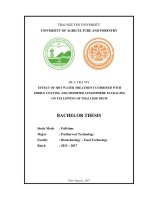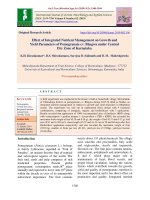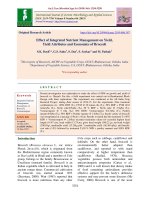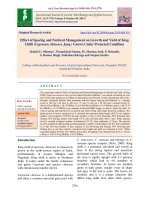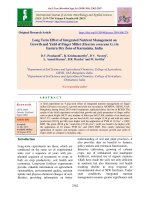Stimulus effect of nutrient management techniques with STCR in field pea crop cultivation under irrigated condition of Chandauli district, Uttar Pradesh, India
Bạn đang xem bản rút gọn của tài liệu. Xem và tải ngay bản đầy đủ của tài liệu tại đây (224.27 KB, 6 trang )
Int.J.Curr.Microbiol.App.Sci (2020) 9(3): 96-101
International Journal of Current Microbiology and Applied Sciences
ISSN: 2319-7706 Volume 9 Number 3 (2020)
Journal homepage:
Original Research Article
/>
Stimulus Effect of Nutrient Management Techniques with STCR in Field
Pea Crop Cultivation under Irrigated Condition of Chandauli District,
Uttar Pradesh, India
Kumar Rishi Ranjan1, Y.V. Singh1*, P. Dey2 and Sukirtee1
1
AICRP on STCR, Department of Soil Science and Agricultural Chemistry,
Institute of Agricultural Sciences, Banaras Hindu University,
Varanasi 221005 (Uttar Pradesh), India
2
Project coordinator STCR (AICRP), Indian Institute of Soil Science,
Bhopal 462 038 (Madhya Pradesh), India
*Corresponding author
ABSTRACT
Keywords
STCR, Fertilizer,
Pea, B:C ratio,
Yield target
Article Info
Accepted:
05 February 2020
Available Online:
10 March 2020
A study is conducted through Soil test Crop Response based (STCR) for the desired
yield targets of pea in an alluvial soil of two different locations of a village- Persiya,
block- Naugharh in Chandauli district during Rabi season2017. For testing of
developed fertilizer prescription equation is necessary to demonstrate the effectiveness
of technology delivery to the farmers field. To evaluate the validation of fertilizer
prescription, experiment was set-up in two locations of Chandauli district, Uttar
Pradesh. Soil samples of the selected crop field locations are studied initially for
analyzing available N, P, K, EC, pH and organic matter status. Treatments were
included as control, farmer practices, general recommended dose of fertilizer and
STCR based fertilizer dose with 5 t ha-1 FYM for targetingyield15 and 20 quintal per
hectare (q ha-1). The treatments were applied and cultivation practices were carried out
periodically and the grain yield was recorded after harvest. With using data on grain
yield and fertilizer doses applied, percent increment in yield and benefit cost (B:C)
ratio were determined. The results of the experiments indicated that in two locations,
the percent achievement of the targeted yield was within±10% variation proving the
validity of the equations for prescribing integrated fertilizer doses for pea. The highest
per cent increment in yield was recorded in the yield target of 20 q ha-1 (39.43 percent)
followed by 15 q ha-1 (9.59 percent) over recommended dose of fertilizers (RDF). The
highest mean grain yield recorded in STCR with 5 t ha-1FYM was 20 q ha-1 (1962.5 kg
ha-1). The highest benefit: cost ratio recorded in T5 treatment (20 q ha-1) was 5.45
followed by T4 treatment (15 q ha-1) was 4.32. The fertilizer prescription equations
developed for pea can be recommended for alluvial soil (Inceptisol) of eastern Utter
Pradesh for achieving a yield target of 20 q ha-1 with higher economic return.
96
Int.J.Curr.Microbiol.App.Sci (2020) 9(3): 96-101
recommending fertilizer dose. In 1967, All
India Co-ordinated Research Project on
STCR, the targeted yield concept is being
widely followed. Targeted yield approach was
first developed by (Troug, 1960) and
(Ramamurthy et al., 1967). The IPNS based
STCR equations are useful and decisive step
towards appropriate dose of chemical
fertilizers
in
combination
with
the
decomposed manures.
Introduction
Field pea (Pisum sativum L.) is a
leguminoceae family crop and commonly
known as ‘Matar’ in India. It is widespread
pulse crop in the world as like in India. It is
consumed as green and yellow pea as a
vegetable and pulse respectively. It contributes
in human diet with protein (27.8%), complex
carbohydrates (42.65%), vitamins, minerals,
dietary fibers and antioxidant compounds
(Urbano et al., 2003). The field peas are
distributed in Asia, Africa, Europe, North
America, Australia, China, Russian Fed,
Ukraine, India, Ethiopia, France, Canada and
USA, these are the leading field Pea producing
countries contributing approximately 75% to
the total global production. India is the second
largest producer of pea in the world after
Russia (Negi et al., 2004). The pea is full of
nutrition because its grain is Pea is the third
most important pulse crop at global level, after
dry bean and chickpea and third most popular
rabi pulse of India after chickpea and lentil.
Uttar Pradesh is the major field pea growing
state producing 60 % of country’s produce.
There is no doubt, for increasing the crop
production, fertilizer is one of the most
essential agricultural inputs. Soil testing is
now being accepted as a technique for
recommending the fertilizer doses for various
crops in India. But it would be beneficial only
when it is based on right knowledge about the
management practices with the interactions of
these factors like soil, crop-variety, fertilizer
and climate. (Kanwar, 1971). Use of plant
nutrients based on soil test helps to get higher
response ratio and benefit-cost ratio as the
nutrient are applied in proportion to the
magnitude of the deficiency of particular
nutrient and the correction of the nutrients
imbalance in soil helps to connect the
synergistic effects of balanced fertilization
(Rao and Srivastava, 2000). Soil test and crop
response (STCR) method is created on soil
contribution and yield level and used for
Materials and Methods
To assess the validation of fertilizer
prescription equation for pea developed by
STCR model, field experiments were carried
out in two different location of two farmers
field of alluvial soil of Utter Pradesh.
Experiments were set up at two locations in
Persiya village, Naugarh block of Chandauli
district, Utter Pradesh. Initial soil samples
were collected from each location and
analyzed for pH determination through1:2.5
soil-water suspensions by potentiometer
method
(Jackson,
1973).
Electrical
conductivity was determined by using
Conductivity Bridge (EC meter) and
expressed in dSm-1 (Jackson, 1973). Organic
carbon through titration method (Walkley and
Black, 1934), available nitrogen (N) by
alkaline permanganate method (Subbiah and
Asija, 1956), phosphorus by Olsen-P reagent
(Olsen et al., 1954), potassium (K) by normal
ammonium acetate method (Hanway and
Heidal, 1952). The initial soil fertility status
for different locations is shown in Table
1.Fertilizer prescription equations developed
for pea under STCR- IPNMS on eastern plain
zone of Utter Pradesh by (Kumar et al., 2018),
are given below:
Nitrogen dose (kgha-1)=FN=4.15 T – 0.27 SN
– 0.09 ON
Phosphorus dose (kg ha-1)=FP = 3.18 T – 2.08
SP2O5 – 0.12 OP2O5
97
Int.J.Curr.Microbiol.App.Sci (2020) 9(3): 96-101
Potassium dose (kg ha-1) =FK= 4.31 T – 0.32
SK2O – 0.14 OK2O
STCR20q ha-1(1962.5 kg ha-1) followed by
STCR15q ha-1(1542.5 kg ha-1), GRD ( 1407.5
kg ha-1) and farmer practices (1075 kg ha-1)
indicating that the STCR treatment with 5 t
ha-1FYM was recorded relatively higher yield
over GRD and Farmer’s practices (Table 3).
Lowest yield recorded in controlled (965.0 kg
ha-1) compare to all other treatments.
STCR20q ha-1 recorded a yield increase of
39.43% over general recommendation dose of
fertilizer. All the treatments are significantly
different in which STCR 20q ha-1 receive
highest mean yield. In the two verification
trials, the per cent achievement of the targeted
yield was within ±10% variation proving the
validity of the equations for prescribing
integrated fertilizer doses for pea. In STCR 20
q ha-1 (Rs.33718), which was highest net
benefit found followed by STCR 15qha-1
(Rs.18760), GRD (Rs.14314) and farmer
practices (Rs.3507). Highest B:C ratio was
recorded in STCR 20 q ha-1 (5.45) followed
by STCR 15 q ha-1 (4.32). So STCR treated
field performed best overall viz., higher yield,
net benefits and B:C ratio compare to others
treated field due to balanced supply of
nutrients from fertilizer, efficient utilization
of applied fertilizer nutrients in the presence
of organic sources and the synergistic as well
as beneficial effect of the conjoint addition of
several sources of nutrients (Singh, 2019 and
Singh et al., 2017).
Where, T=Grain yield target in q ha-1; SN, SP
and SK are available N, P and K through soil
in kg ha-1whereas ON, OP and OK are N, P
and K supplied through FYM in kg ha-1
respectively. The treatments executed were as
follows:
(i)Control(T1),
(ii)
Farmer’s
Practices(T2), (iii) General Recommended
Dose(T3),(iv) STCR based fertilizer dose with
5 t ha-1 FYM for an yield target of 15 q ha1
(T4) and (v) STCR based fertilizer dose with
5 t ha-1 FYM for an yield target of 20 q ha1
(T5). Based on the initial soil test values of
available N, P and K and the quantities of N,
P2O5 and K2O supplied fertilizer doses were
calculated and suggested for STCR treatments
for various yield targets.
Full dose of N, P2O5 and K2O were applied
initially and other packages of practices were
carried out periodically. Using the data on
grain yield and fertilizer doses applied, the
parameters viz., B:C ratio was worked out
based on the price of the produce and cost
incurred for the cultivation as per the standard
procedure.
Results and Discussion
The highest mean grain yield between the two
farmers field were recorded in the treatment
Table.1 Initial soil fertility status of the different locations of Village-Persiya, Naugarh block in
district Chandauli
Locations
1.
2.
pH
Farmers Name
Smt. Kishmati Devi w/o Shri 7.28
Ramlakhan
Smt. Prabhawati w/o Shri Ganesh
7.30
98
E.C.
(dSm-1)
OC
(%)
Avai. N
(kg ha-1)
Avai. P
(kg ha-1)
Avai. K
(kg ha-1)
0.41
0.71 182.00
20.90
179.90
0.42
0.68 178.20
21.20
181.00
Int.J.Curr.Microbiol.App.Sci (2020) 9(3): 96-101
Table.2 Treatments of fertilizer doses (kg ha-1) imposed under different locations of VillagePersiya, Naugarh block in district Chandauli
Treatments
Location 1
Location 2
N
P
K
N
P
K
Control
0
0
0
0
0
0
Farmer’s practice
10
20
15
10
20
15
GRD
20
40
30
20
40
30
STCR15 q ha
-1
19
27
20
19
27
20
STCR20 q ha
-1
40
43
41
40
43
41
Where: GRD – General Recommended Dose and STCR-Soil Test Crop Response
Table.3 Grain yield, net benefits and B: C ratio of pea crop under different locations of VillagePersiya, Naugarh block in district Chandauli
Treatments
T1-0-0-0
T2-10 -20 - 15
T3-20 - 40 30
T4- 19 - 2720-5
T -40 - 43 41-5
C.D at 5%
Grain yield (kg
ha-1) Locations
Mean Increment Value of
Cost of
Net
B/C
(kgha-1) in yield
additional fertilizer benefit ratio
over T1
yield
(Rs.)
(Rs.)
(kg ha-1)
(Rs.)
1
985
2
945
965.0
-
-
-
-
-
1,115
1,415
1075
1400
1095.0
1407.5
130
442.5
5200
17700
1693
3386
3507
14314
2.07
4.23
1,555
1530
1542.5
577.5
23100
4340
18760
4.32
1,995
1930
1962.5
997.5
39900
6182
33718
5.45
3.989
4.223
-
-
-
-
-
Note: Pea @Rs.40.00/kg, /kg, P /kg, /kg
T1 – Control, T2- Farmer’s Practices, T3- GRD (General recommended Dose)
T4- Target yield (1500 kg ha-1) with FYM 5t ha-1 and T5- Target yield (2000 kg ha-1) with FYM 5t ha-1
99
Int.J.Curr.Microbiol.App.Sci (2020) 9(3): 96-101
Table.4 Post-harvest soil fertility status of various treatments under different locations of
village-Persiya, Naugarh block in district Chandauli
Treatments
N
Location 1
P
K
N
Location 2
P
Control
211
16.2
192
209
16.5
190
Farmer’s practice
224
18.3
201
223
17.2
198
GRD
STCR 15 q ha-1
STCR 20 q ha-1
CD at 5%
237
19.1
203
228
18.4
203
241
19.7
211
233
19.8
211
241
6.47
21.5
1.56
213
4.78
246
21.9
214
3.97
2.07
4.23
Where: GRD – General recommended dose and STCR-Soil teat crop response
Post-harvest soil values revealed that a
sufficient build up and maintenance of SN, SP
and SK are found under STCR study compare
to farmer practices and general recommended
dose. Despite removal of higher amount of
nutrient in STCR treatment due to getting a
higher yield, higher post-harvest soil fertility
was observed in STCR plot. The highest postharvest soil nitrogen, phosphorus and
potassium found in STCR for 20 q ha-1 were
246.00 kg ha-1, 21.90kg ha-1and 214 kg ha-1in
location-1, respectively shown in table 4.
Higher consistent profit with maintaining soil
fertility status was realized when fertilizer
was applied for suitable yield targets in
succession over years using STCR concept
(Singh et al. 2015).The greater buildup of
nutrient in STCR treated field was due to
balance application of chemical fertilizer in
conjoint with organic manure source.
Combination of FYM organic source with
fertilizers improved the chemical and physical
properties, which led to enhance and
sustainable crop production.
K
use of costly fertilizer inputs depending on
their financial status and prevailing market
price of the crop under consideration.
Acknowledgement
The authors are grateful to Indian Institute of
Soil Sciences, Bhopal for providing financial
assistance through AICRP on STCR project
during the farmers’ field experiment.
References
Hanway, J.J., Heidal, H. Soil analysis
methods as used in Iowa State CollegeSoil Testing Laboratory. Iowa State
College Bull 1952; 57, 1-131.
Jackson, M.L. Soil Chemical Analysis.
Prentice Hall of India Pvt. Ltd. New
Delhi 1973.
Kanwar, J. S. Soil Testing Service in India –
retrospect and prospect. Proceedings of
international symposium on soil fertility
evaluation. New Delhi 1971; I:11031113.
Kumar Rishi Ranjan, Y.V. Singh, S.K. Singh
and
P.
Dey.
Fertilizer
Recommendations Developed through
Soil Test Crop Response Studies with
Integrated Plant Nutrient Management
System for Field Pea in an Inceptisol.
Journal of the Indian Society of Soil
On the basis of results of experiment which
we found, we can say that the study will help
to make guidelines for the amount of fertilizer
used in field pea cultivation. The specific
yield equation based on soil health will not
only ensure sustainable crop production but
will also steer the farmers towards economic
100
Int.J.Curr.Microbiol.App.Sci (2020) 9(3): 96-101
Science 2018; 66(3): 318-323.
Negi, Susheela, Singh, R.V. and Dwivedi,
G.K. Effect of biofertilizers, FYM,
NPK and lime on pea in acidic soil of
Uttaranchal hills. Vegetable Science
2004; 31:193 -195.
Olsen, S.R., Cole, C.V., Watanabe, F.S.,
Dean, L. Estimation of available
phosphorus in soils by extraction with
sodium bicarbonate (USDA Circular
939). Washington, D. C.: U. S.
Government Printing Office 1954.
Ramamoorthy, B., Narasimham., R.L. and
Dinesh, R.S. Fertilizer application for
specific yield targets on Sonora 64
(wheat). Indian Farming 1967; 17: 4345.
Rao, A. S., and Srivastava, S. Soil Test Based
Fertilizer Use-a must for Sustainable
Agriculture. Fertilizer News 2000;
45:25-38.
Singh, Y. V. Target Yield through Soil Test
Crop Response Technology of Wheat in
Chandauli district of Uttar Pradesh.
Technofame
A
Journal
of
Multidisciplinary Advance Research
2019; 8 (1): 1-6.
Singh, Y.V. and Dey, Pradip., S.K., Singh and
Kumar, Mukesh. Impact of soil test crop
response technology on yield and
economics of wheat in Chandauli
district of Uttar Pradesh. Technofame A Journal of Multidisciplinary Advance
Research 2015;1: 52 - 56.
Singh, Y.V., Singh, S.K. and Dey, Pradip.
Nutrient Management for Chick pea
Using Soil Test Target Yield Equation
in Hadahi village, Chandauli district of
Uttar Pradesh. Technofame - A Journal
of Multidisciplinary Advance Research
2017;6(1): 153-157.
Subbiah, B.V. and Asija, G.L. A rapid
procedure for estimation of available
nitrogen in soils. Current Science 1956;
25: 259-60.
Truog, E. Fifty years of soil testing. Proc.
Trans 7th International congress soil
science 1960;III-IV (7):46-53
Urbano, G. P., Aranda and Villalva, E. G.
Nutritional evaluation of pea (Pisum
sativum L.) protein diets after mild
hydrothermal treatment and with and
without added phytase. Journal of
Agricultural and Food Chemistry 2003;
51: 2415–2420.
Walkley. A. and Black I.A. An Examination
of the Degtjareff Method for
Determining Soil Organic Matter, and a
Proposed Modification of the Chromic
Acid Titration Method. Soil Science
1934; 27: 29-38.
How to cite this article:
Kumar Rishi Ranjan, Y.V. Singh, P. Dey and Sukirtee. 2020. Stimulus Effect of Nutrient
Management Techniques with STCR in Field Pea Crop Cultivation under Irrigated Condition
of Chandauli District, Uttar Pradesh, India. Int.J.Curr.Microbiol.App.Sci. 9(03): 96-101.
doi: />
101

